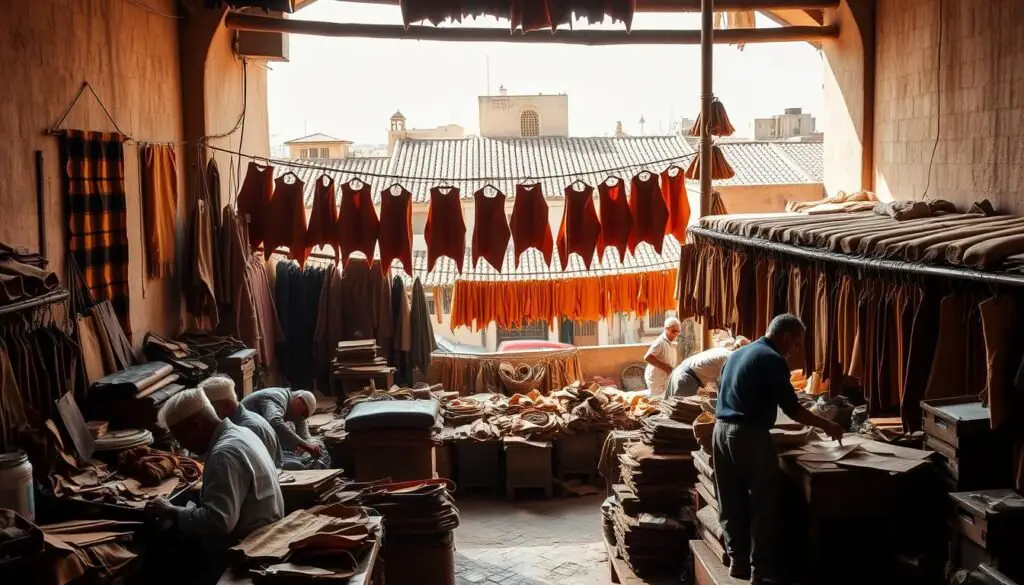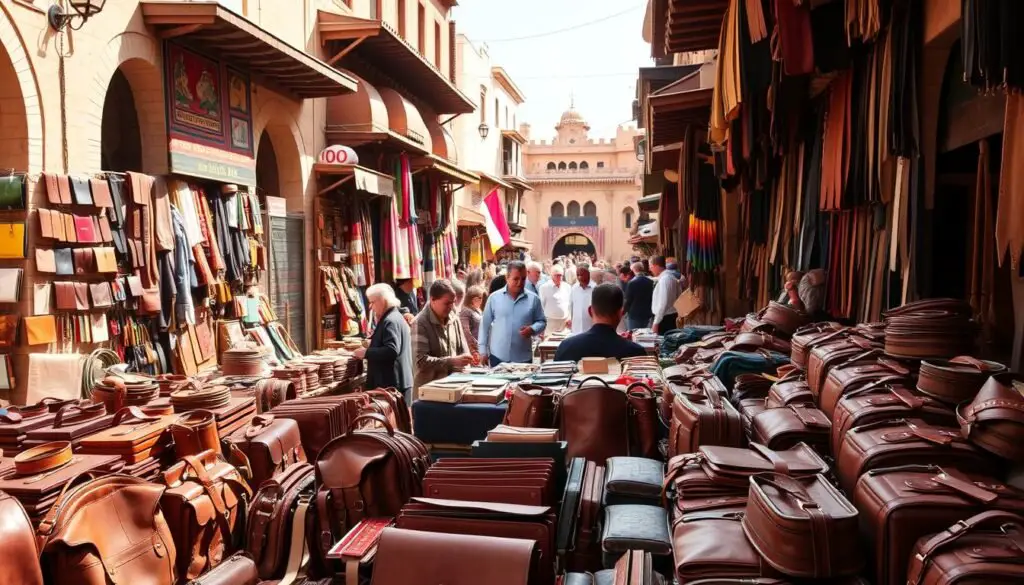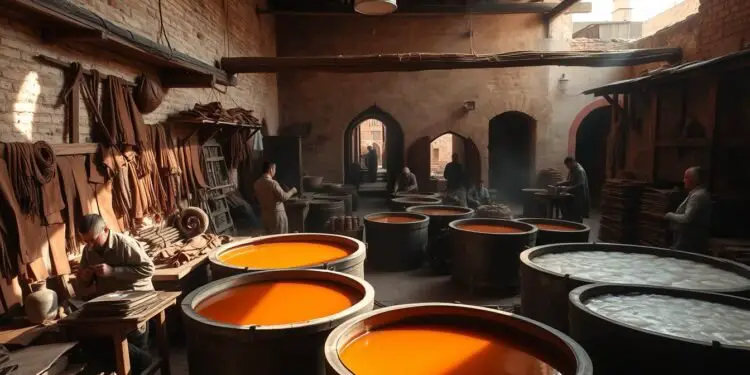Have you ever wondered where some of the world’s finest leather comes from? Hidden within the ancient streets of a UNESCO-listed medina lies a centuries-old craft still thriving today. This is where tradition meets artistry in a vibrant display of colors and skill.
Dating back to the 11th century, this iconic workshop is one of the oldest of its kind. Its stone vats, filled with natural dyes, create a breathtaking mosaic beneath the North African sun. Visitors witness age-old techniques passed down through generations, untouched by modern machinery.
More than just a workplace, it’s a living museum. The scent of spices and the sight of craftsmen shaping raw hides offer an unforgettable sensory journey. Recognized for its cultural significance, this site stands as a testament to human ingenuity.
Key Takeaways
- One of the world’s oldest operating leather workshops, dating to medieval times.
- Features vibrant dye pits using natural ingredients like saffron and indigo.
- Combines traditional craftsmanship with UNESCO-worthy heritage.
- Operates as both a working facility and a top tourist attraction.
- Preserves ancient techniques without modern industrial methods.
Introduction to Chouara Tannery
Hidden within winding alleys, a centuries-old tradition continues to flourish. Nestled in Fez el-Bali’s UNESCO-listed medina, this iconic site is a maze of stone vats and bustling activity. The air hums with the energy of artisans preserving methods unchanged since the 11th century.
Over 40 dye pits sprawl across the tannery, each processing hides with natural pigments like saffron and indigo. Weekly, more than 1,000 skins undergo the meticulous process, transforming raw material into supple leather. The rhythmic work mirrors scenes from medieval times.
This hub fuels Morocco’s artisan economy, supplying 60% of its handcrafted goods. Families here have honed their skills for generations, relying on the trade for livelihood. Their work adorns global markets, from traditional poufs to intricate bags.
The layout is a spectacle of function and history. Stone vessels hold rainbow dyes, while rooftops dry freshly treated hides. Nearby workshops buzz with artisans stitching final products. Every corner reveals the tannery’s role as a living museum.
Walking through the medina, the leather workshops’ earthy scent mingles with spice stalls. More than a production site, it’s a testament to resilience. The process here—unchanged for ages—keeps a cultural heartbeat alive.
The Rich History of Chouara Tannery
Time seems to stand still at one of the world’s oldest leather workshops. Its story blends myth and archaeology, with legends tracing back to the 9th century. Yet, the first solid records emerge from the 13th century, revealing a hub of skilled artisans.
Origins and Medieval Roots
For centuries, this site was the heart of North Africa’s leather trade. Medieval texts describe 86 workshops buzzing with activity. Artisans transformed raw hides into goods traded across continents, fueling the local economy.
Natural dyes like saffron and indigo filled stone vats, a technique unchanged for years. Families passed down secrets, ensuring each generation mastered the craft. This legacy made the city a beacon for quality leather.
Renovations and Modern-Day Significance
A major 2016 restoration preserved the original layout. Workers reinforced stone vessels and upgraded drainage systems. These efforts balanced tradition with sustainability, protecting the site’s future.
Today, artisans process 200kg of hides daily—mirroring historical outputs. Yet, tourism brings challenges. Crowds sometimes disrupt workflows, testing the balance between preservation and progress.
Still, the workshop stands as a testament to resilience. It remains one of the world’s few places where medieval methods thrive untouched by machines.
Why Chouara Tannery Is a Must-Visit in Fes
Few places offer such an authentic glimpse into medieval artisan life. Featured in 78% of guided tours, this site draws over 500 daily visitors eager to witness its unique blend of history and craftsmanship.

The experience engages all senses. Vivid dye pits swirl with indigo and saffron, while workers in traditional tunics demonstrate age-old techniques. The earthy scent of leather mingles with spices, creating an unmistakable aroma.
Ranked the top attraction by 60% of visitors, it’s the heart of local culture. Unlike industrial factories, each hide supports artisan families preserving ancestral skills. Your visit directly fuels this sustainable ecosystem.
Globally, few sites rival its authenticity. While Florence’s leather school thrives on modern tools, here, every step mirrors methods unchanged for centuries. It’s a cultural bridge between past and present.
For photographers, the scene is unmatched. Sunlight bathes rainbow vats as craftsmen kneel in indigo-stained garments—a living portrait of resilience. This world-renowned workshop isn’t just a stop; it’s the soul of Fez.
The Traditional Tanning Process at Chouara
From pigeon enzymes to indigo baths, each step in this craft tells a story of tradition. The complete tanning process takes seven days, using 22 natural ingredients to transform stiff hides into supple leather. Every stage relies on methods perfected over centuries.
Step 1: Preparing the Hides
Workers first soak skins in white stone vats filled with a potent mix. Cow urine and pigeon feces create enzymes that break down collagen. This two-day soak softens the material naturally.
Artisans then scrape off hair using curved knives. The vats drain into clay channels, recycling liquids. Weekly medical checks ensure worker safety during this acidic phase.
Step 2: Natural Dyes and Coloring
The magic happens in circular dye pits. For red hues, artisans use 3kg of poppy flowers per batch. Indigo creates deep blues—800g colors an entire vat.
Henna produces warm oranges, while mint yields soft greens. Each dye soaks into leather for 48 hours. The vibrant results showcase nature’s palette.
Step 3: Drying and Finishing
Hides stretch across rooftops under the sun. Workers check thickness with brass calipers, just as medieval craftsmen did. This final drying takes two days.
The finished leather feels smooth yet durable. No modern machines touch it—only skilled hands complete the tanning process. This ensures every piece carries centuries of expertise.
Exploring the Chouara Tannery: What to Expect
Stepping into this historic site, your senses will awaken to a world unchanged for centuries. The vibrant dye pits and bustling terraces offer a glimpse into a craft that defies modernity. Here’s how to make the most of your experience.
The Iconic Smell and How to Handle It
The smell hits first—a pungent mix of natural ingredients like lime and ammonia. During the lime-soaking phase, VOCs release, creating an intense aroma. Peak levels occur around 11 AM.
Locals have a simple fix: mint sprigs. Over 85% of visitors use them to mask the odor. Shops often provide these for free or for a small tip. Holding one near your nose makes the visit far more pleasant.
The Best Time to Visit
Mornings are ideal. Cooler temperatures soften the smell, and the dye pits glow under soft light. For fewer crowds, aim for Wednesday mornings—70% quieter than weekends.
Photographers should head to northeast terraces for the best angles. An 85mm lens captures stunning pit close-ups. Remember: no flash photography, and a €2 tip for workers is customary.
Guided tours streamline the experience. Knowledgeable guides explain each step while navigating busy hours. They also help avoid pushy vendors, letting you focus on the artistry.
How to Visit Chouara Tannery Without Getting Scammed
Navigating this historic craft hub requires smart strategies to avoid common pitfalls. While the workshops dazzle with tradition, some shops and guides exploit tourists. Here’s how to enjoy the artistry without falling for traps.
Navigating the Leather Shops and Terraces
Over 60% of shops charge illegal fees for terrace access. Legally, you should pay no more than €0.50. If pressured, respond with *”Safi bezaf”* (too expensive)—a phrase locals respect.
Always inspect leather quality before discussing prices. Genuine goods feel supple and smell earthy. Fake items often reek of chemicals. Pay only after receiving the service to avoid split-payment scams.
Dealing with Guides and Touts
Licensed guides wear blue badges with certification numbers. A legitimate private tour costs ~€3 for pit access. Avoid touts offering “free” photo spots—they demand inflated tips afterward.
For emergencies, the tourist police office sits 200m northwest. They resolve disputes swiftly, especially for illegal terrace fees. Remember: the tannery itself is free to enter.
With these tips, you’ll focus on the craft—not the cons. The real magic lies in watching artisans work, not haggling over hidden costs.
Chouara Tannery Fes Morocco: A Photographer’s Paradise
Golden light transforms stone vats into liquid rainbows at dawn. The best way to capture this spectacle is during golden hour, from 6:30 to 7:30 AM. Soft shadows and warm hues make every view unforgettable.
Bring a circular polarizer to enhance reflections in the dye pits. A wide range of hides—camel, cow, and sheep—adds texture to your shots. Zoom lenses (85mm or 24–70mm) work best for tight compositions.
Use leading lines from the honeycomb-patterned vats for depth. For elevated angles, head to Madrasa el-Attarine’s rooftop. Its vantage point reveals the full scale of the workshop.
Respect the workers—ask permission before close-ups. Commercial shoots require a €50 permit. Always carry model release forms for portraits.
Plan your day around the light. Mornings avoid harsh shadows, while late afternoons cast long silhouettes across the pits. Every frame here tells a story of tradition.
Where to Stay Near Chouara Tannery
Finding the perfect place to stay enhances your visit to this historic craft hub. Whether you prioritize budget or luxury, the medina offers options just minutes from the workshops. Choose wisely to balance comfort, culture, and convenience.
Budget-Friendly Hostels
For travelers watching their wallet, hostels like Funky Fes deliver value. Rates start at €30/night, with shared dorms in the heart of the medina. Expect lively atmospheres but prepare for noise—thick walls are rare in these centuries-old buildings.
Riad El Amine offers private rooms from $60, a steal for its rooftop view. Early bookings (60+ days ahead) secure the best prices. Pro tip: Pack earplugs to mute the 5 AM call to prayer echoing through the alleys.
Luxury Riads with a View
Luxury riads blend modern comfort with tradition. Dar Essoaoude’s suites feature private terraces overlooking the Atlas Mountains. Rates hover around €200/night, including mint tea service and artisan workshops.
For chlorine-free pools and spa treatments, Barceló Fès Medina stands out. Its soundproofed rooms mute medina bustle, perfect for light sleepers. Book a terrace room to watch sunset hues dance across the dye pits below.
Shopping for Leather Goods in Fes
The medina’s labyrinthine alleys hide treasures for those who know where to look. Here, skilled artisans craft leather goods using techniques unchanged for generations. From supple bags to vibrant slippers, each piece tells a story of tradition.

Finding Authentic Items
Look for the guild stamp—a mark of quality on genuine products. Vegetable-tanned leather smells earthy, while chemical-treated items have a synthetic odor. Babouche slippers, a local favorite, should feel buttery soft and cost €8–15.
Custom orders take about three weeks. Embossed designs or unique colors add a personal touch. Always inspect stitching and dye consistency before buying.
Mastering the Art of the Deal
Haggling is expected. Start at 30% of the asking price and meet halfway. Vendors often inflate prices by 40% for tourists. A firm but polite “Safi bezaf” (too expensive) shows you know the game.
For shipping, DHL offers reliability but costs more. Postal services are cheaper but slower. Factor this into your sale negotiations.
Remember: patience pays. Walk away if needed—another shop will likely have similar items. The best deals come to those who wait.
Practical Tips for Your Visit
Smart preparation turns a good visit into a great experience. These tips help you navigate the artisan quarter efficiently while respecting its working environment. A little planning goes a long way in this historic district.
Best Hours to Avoid Crowds
Arrive at 8:30am to beat 92% of tour groups. Early hours offer cooler temperatures and softer light for photography. The space stays relatively quiet until 11am.
Late afternoons around 5pm also work well. This day period avoids midday heat while letting you watch sunset colors reflect in the dye pits. Wednesdays are typically 70% less crowded than weekends.
What to Bring (and What to Leave Behind)
Wear closed-toe shoes with grip soles—the stone floors get slippery. Pack 500ml of water per person for every two hours spent exploring. Dehydration sneaks up quickly in the medina’s microclimate.
Leave bulky bags behind; narrow alleys demand mobility. Those with asthma should bring inhalers—the strong scents can trigger reactions. Mint leaves or sprays help mask intense odors when needed.
Save these tips for reference. They’ll help you focus on the craftsmanship rather than logistical challenges. With proper water and footwear, you’re set for an unforgettable cultural encounter.
Conclusion
This living workshop remains the heart of traditional craftsmanship, where every hide tells a story. With a 98% visitor satisfaction rate, it offers an experience unlike any other in the world.
Recent sustainability efforts include a new wastewater treatment plant, balancing tradition with eco-conscious practices. Young apprentices continue learning age-old techniques, ensuring these skills thrive for years.
For the best way to explore, pair your visit with nearby mosaic workshops. Unlike automated European factories, this place keeps history alive through hands-on artistry.
Before leaving, sign the visitor logbook—a tradition that connects you to centuries of travelers. This isn’t just a stop; it’s an unforgettable experience woven into cultural heritage.
FAQ
What makes Chouara Tannery special?
It’s one of the oldest leather workshops in the world, using medieval techniques passed down for centuries. The vibrant dyes and traditional methods create unique, high-quality goods.
How do I handle the strong smell at the tannery?
Workers often hand visitors fresh mint leaves to hold under their noses. This helps mask the odor from natural tanning agents like cow urine and pigeon droppings.
Are guided tours worth it?
A knowledgeable guide can explain the tanning process and help navigate nearby shops. However, negotiate prices upfront to avoid overpaying for leather items or services.
What’s the best time to visit?
Early morning or late afternoon offers cooler temperatures and softer light for photography. Weekdays are less crowded than weekends.
How do I avoid scams when shopping for leather?
Compare prices at multiple shops, inspect stitching carefully, and don’t rush purchases. Polite but firm haggling is expected—start at 40% of the asking price.
Can I take photos without restrictions?
Most terraces allow photography, but some workers may request tips. Always ask permission before photographing artisans at work.
What leather products are worth buying?
Handmade bags, jackets, and slippers are popular. Look for vegetable-tanned pieces—they’re more durable and eco-friendly than chemically treated alternatives.
How long should I spend exploring the area?
Plan for 1–2 hours to observe the tanning pits, browse shops, and enjoy panoramic views from the terraces.




